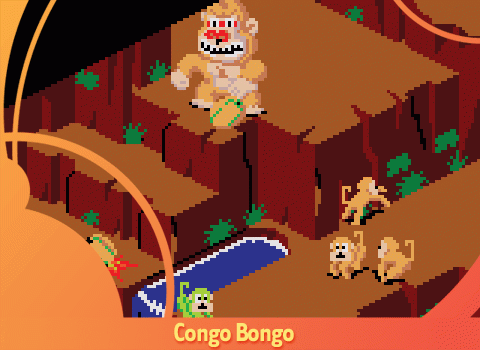GameSpite Journal 12 may be the biggest Donkey Kong rip-off this side of Monkey Donkey. Nevertheless, the coupon code WONDERFUL will net you 15% off through August 31 on our Blurb store.

Congo Bongo certainly wears its influences on its sleeve; I would be hard pressed to tell you that’s not Donkey Kong on the cabinet art if it weren’t for the fact that he’s facing off against some hapless safari adventurer in a pith helmet instead of a carpenter. The first level even involves the big ape throwing round bouncing objects down at you as you attempt to climb your way up to his position. Admittedly, I don’t remember Kong ever mischievously setting fire to Mario’s house, but still.
That’s about where the similarities between Congo Bongo and Donkey Kong (two years its senior) end, though. Sega’s game is presented in a striking isometric perspective with relatively complex play fields. On top of that it changes up the layouts and obstacles so much from one screen to the next that it almost feels less like a standard old-school arcade game and more like something halfway to a WarioWare game, sampling slightly different genres with each challenge.
Of course, it actually is an old-school arcade game, which means three lives to start, instant death for the slightest mis-step or enemy collision, and no continues. Thus you need either the patience to master each layout, quick fingers, and a bit of luck… or save states. Either way, we press onward.

The first level, as mentioned, has our hero climbing an isometric mountain while avoiding coconuts hurled by the angry ape. Fairly straightforward, but filled with some nice touches like a slide, a waterfall bridge that collapses once you’ve jumped past it, and three little monkeys who can team up to throw you off the mountain. Next we switch gears to a flat lake with islands connected by bridges. The main challenge here is avoiding the snakes akin to those seen in Zelda, which charge forward when they see you. Clever bait-and-switch maneuvers can get you past. Farther on we meet some extremely aggressive rhinos which can be dodged, trapped in gopher holes, or jumped over with expert timing. Another level is reminiscent of Frogger, with the hero jumping on lily pads, hippos, and fish.
Unfortunately, all the varied graphics on display here only left room for four levels, after which your avatar manages to sneak up on the big ape and extract his just revenge. Then, as was de rigueur for the time, we loop back around to do it again but with feeling, the stakes upped by more plentiful enemies and other small tweaks.
The short and specific nature of Congo Bongo doesn’t allow it the timeless “simple to learn, hard to master” appeal of arcade classics like Pac-Man, Space Invaders, or (it must be said) Donkey Kong. But its variety makes it quite an interesting diversion to play through once or twice. It contains familiar flavors but puts them together in a brief confection that’s not quite like anything I’ve played before. Definitely worth a look for aficionados of arcade platforming action.
Article by Ben Elgin
GameSpite Journal 12: Congo Bongo
Your consistent pace of posting articles from the latest issue has not gone unnoticed. Very much appreciated!
You’re right, it hasn’t gone unnoticed! Traffic has dropped quite a bit. *sad trombone* People don’t care about Sega.
Being one of the earlier isometric games, I’m curious about how Congo Bongo’s controls work. Does Up equal Northeast or Northwest, or does it pull weird stuff like tank controls or Landstalker locking you into a diagonal axis?
MetManMas - I dunno what the controls looked like on the arcade cabinet, but in emulation at least it does simply map the usual cardinal directions onto the isometric perspective. Up is always Northeast, which is where the ape is hanging out. You get used to it pretty quick.